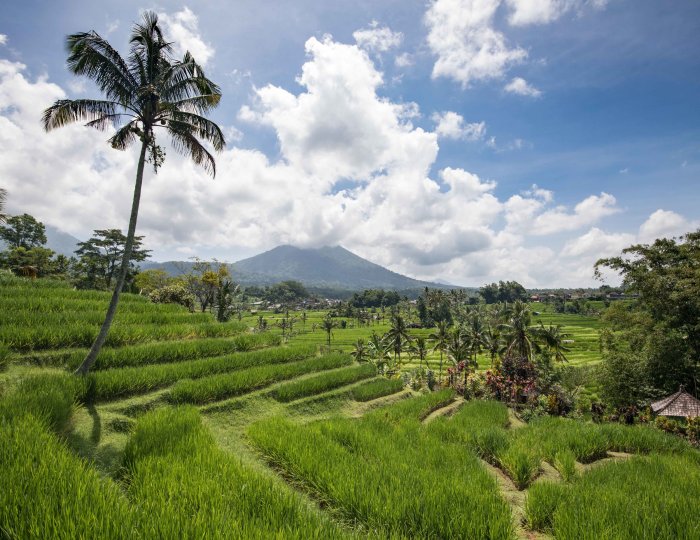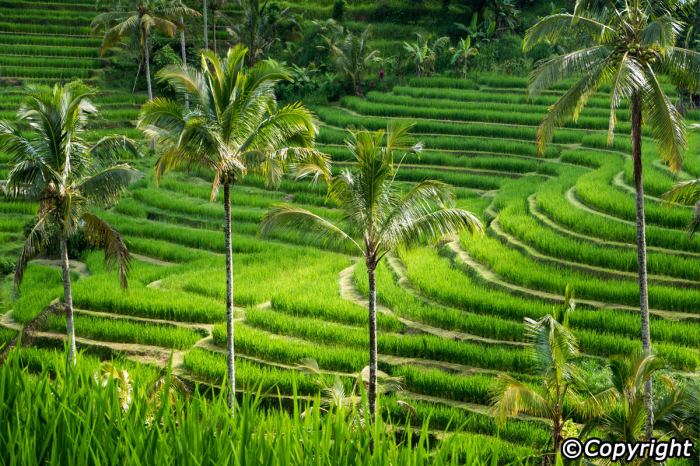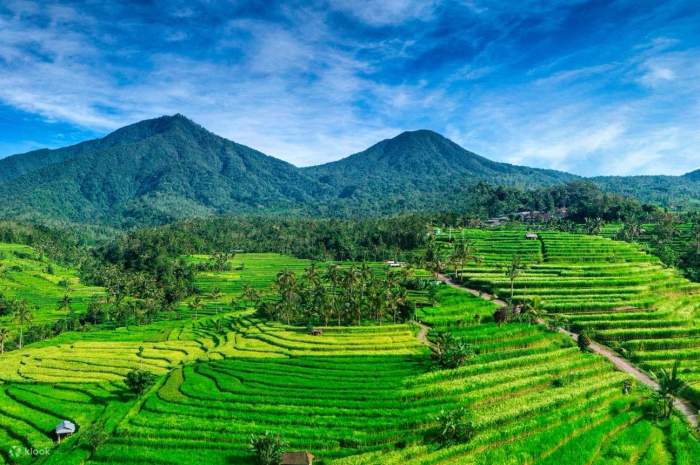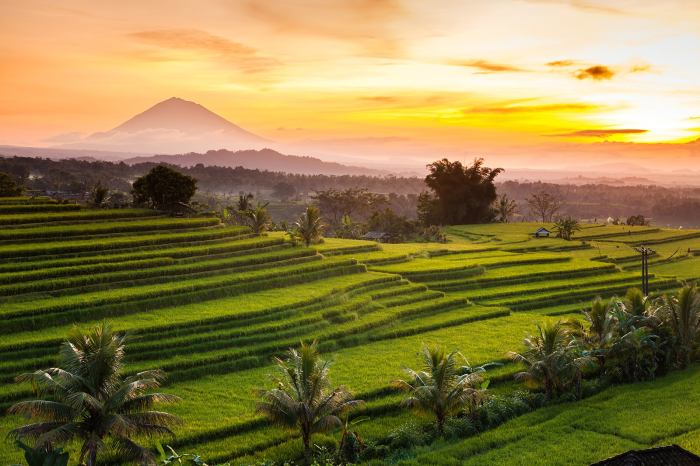Nestled amidst the verdant hills of Bali, the Jatiluwih Rice Terraces stand as a testament to the harmonious coexistence of nature and human ingenuity. These meticulously sculpted landscapes, a UNESCO World Heritage Site, offer a captivating glimpse into the rich cultural heritage and agricultural practices of the region.
Carved into the slopes of Mount Batukaru, the terraces extend over 600 hectares, creating an intricate tapestry of emerald hues. Their unique irrigation system, known as Subak, has been passed down through generations, ensuring a sustainable water supply for the rice cultivation.
Historical Background of Jatiluwih Rice Terraces
Nestled amidst the verdant hills of Bali, Indonesia, the Jatiluwih Rice Terraces stand as a testament to centuries-old agricultural practices and cultural heritage. Their origins trace back to the 9th century, during the reign of King Udayana of the Warmadewa dynasty.
According to local legend, the king was inspired by the beauty of the surrounding landscape and commissioned the construction of a sophisticated irrigation system to harness the abundant water resources of the area. The terraces were designed to mimic the natural contours of the land, ensuring optimal water distribution and maximizing crop yields.
Jatiluwih Rice Terraces, a UNESCO World Heritage Site, boasts breathtaking emerald-hued rice paddies cascading down the slopes of Mount Batukaru. After a day of exploring these serene landscapes, unwind at Burza Hotel Jogja , a charming boutique hotel in the heart of Yogyakarta.
With its elegant ambiance and exceptional service, Burza Hotel Jogja offers a luxurious respite amidst the cultural richness of the city. Upon returning to Jatiluwih Rice Terraces, delve deeper into the ancient traditions and practices that have shaped these extraordinary landscapes.
Cultural Significance
Beyond their agricultural importance, the Jatiluwih Rice Terraces hold deep cultural significance for the Balinese people. They are considered a sacred landscape, a symbol of harmony between humans and nature. The terraces are an integral part of the local religious ceremonies and festivals, reflecting the Balinese belief in the interconnectedness of all living things.
The traditional farming practices employed at Jatiluwih are based on the ancient concept of Tri Hita Karana, which emphasizes balance and harmony among humans, nature, and the divine. This philosophy is reflected in the sustainable agricultural methods used by local farmers, ensuring the long-term preservation of the terraces and their unique ecosystem.
Geographical Features of the Terraces
Nestled in the heart of Bali’s Tabanan Regency, the Jatiluwih Rice Terraces showcase a breathtaking landscape that has earned it UNESCO World Heritage Site status. The terraces are situated at an elevation ranging from 500 to 700 meters above sea level, amidst the picturesque Mount Batukaru and the verdant Ayung River valley.
Spanning an impressive 636 hectares, the terraces are meticulously laid out in a complex system of stepped contours that follow the natural topography of the land. The size and layout of the terraces vary, with some reaching up to 100 meters in length and 15 meters in width.
The intricate network of irrigation channels, known as subaks, crisscrosses the terraces, ensuring a steady supply of water for the rice cultivation.
Irrigation System
The unique irrigation system employed in the Jatiluwih Rice Terraces is a testament to the ingenuity and agricultural prowess of the local farmers. The subaks, which originate from a nearby spring, are meticulously designed to distribute water evenly throughout the terraces.
The water is channeled through a series of bamboo pipes and stone aqueducts, ensuring that each rice paddy receives the optimal amount of water it needs to thrive.
Ecological Importance of the Terraces

Jatiluwih Rice Terraces are not just a breathtaking sight; they also play a crucial role in maintaining the local ecosystem and biodiversity. The intricate network of terraces creates a mosaic of habitats that support a wide range of flora and fauna.
Soil Conservation, Jatiluwih rice terraces
The terraces act as natural barriers against soil erosion. The steep slopes of the terrain would otherwise be vulnerable to runoff, which could wash away valuable topsoil. The terraces slow down the flow of water, allowing the soil to settle and preventing erosion.
Water Management
The terraces also play a vital role in water management. They act like small reservoirs, capturing and storing rainwater during the wet season. This water is then slowly released into the soil during the dry season, providing a continuous supply of water for the rice paddies.
Habitat for Flora and Fauna
The terraces provide a diverse habitat for a variety of plants and animals. The rice paddies themselves support a rich aquatic ecosystem, while the surrounding areas are home to a variety of trees, shrubs, and grasses. These plants provide food and shelter for numerous bird species, insects, and reptiles.
Jatiluwih Rice Terraces, a UNESCO World Heritage Site, is renowned for its breathtaking views. Its verdant rice paddies cascade down the hillsides, creating a picturesque landscape. For a spiritual experience, take a day trip to the sacred Uluwatu Temple , perched on a cliff overlooking the Indian Ocean.
After exploring the temple’s ancient ruins and witnessing its iconic sunset Kecak dance, return to the serenity of Jatiluwih Rice Terraces, where you can immerse yourself in the tranquility of nature.
Cultural Heritage and Tourism
The Jatiluwih Rice Terraces hold immense cultural and religious significance for the local community. The terraces are an integral part of the Subak irrigation system, a traditional water management system that has been passed down through generations. The Subak system is based on the principles of cooperation and communal responsibility, and it has played a vital role in the preservation of the terraces and the surrounding environment.The terraces are also a source of great pride for the local people.
They are a symbol of their agricultural heritage and their connection to the land. The terraces are also a popular tourist destination, and they play an important role in the local economy.
Role in Tourism and Economic Development
The Jatiluwih Rice Terraces are a major tourist attraction in Bali. The terraces offer stunning views of the surrounding countryside, and they are a popular spot for hiking, biking, and photography. The terraces have also been featured in several films and television shows, which has helped to raise their profile and attract even more visitors.Tourism has had a positive impact on the local economy.
The terraces have created jobs for local people, and they have also helped to boost the sale of local products and services. The terraces have also helped to raise awareness of the Subak irrigation system, and they have inspired other communities to adopt similar sustainable farming practices.
Preservation and Promotion
The Jatiluwih Rice Terraces are a UNESCO World Heritage Site, and they are protected by law. The local government has also taken steps to preserve and promote the terraces. These steps include:
- Establishing a conservation zone around the terraces.
- Regulating the use of pesticides and fertilizers.
- Promoting sustainable farming practices.
- Educating visitors about the importance of the terraces.
The efforts to preserve and promote the Jatiluwih Rice Terraces have been successful. The terraces are now a thriving tourist destination, and they continue to play an important role in the local economy. The terraces are also a reminder of the importance of traditional farming practices and the need to protect the environment.
Agricultural Practices and Sustainability: Jatiluwih Rice Terraces

The Jatiluwih Rice Terraces showcase traditional farming methods that have been passed down through generations. Farmers rely on natural resources and sustainable practices to maintain the delicate ecosystem of the terraces.
One of the key agricultural practices is the use of subak, a traditional water management system. The subaksystem ensures equitable distribution of water to all the terraces, allowing farmers to cultivate rice throughout the year. Farmers also practice crop rotation, planting legumes and other crops to improve soil fertility and prevent pests.
Challenges to Sustainability
Farmers in Jatiluwih face several challenges in maintaining sustainable practices. Climate change, with its unpredictable rainfall patterns and extreme weather events, poses a significant threat to the terraces. Additionally, the increasing demand for land for tourism and development puts pressure on the traditional farming practices.
Jatiluwih Rice Terraces, a UNESCO World Heritage Site, offers breathtaking vistas of verdant rice paddies cascading down the hillsides. Just a short drive away is the sacred pura lempuyang , known for its iconic “Gates of Heaven.” After exploring the temple’s mystical allure, return to Jatiluwih Rice Terraces for a peaceful stroll amidst the tranquil beauty of nature, where you can soak in the serenity of the surroundings.
Initiatives for Sustainability
To address these challenges, various initiatives have been implemented to promote sustainable agriculture and preserve the Jatiluwih Rice Terraces. The government has introduced regulations to protect the terraces from development and promote eco-tourism. Local communities have also formed cooperatives to support farmers and implement sustainable farming practices.
Education and awareness programs are also crucial in promoting sustainability. Farmers are encouraged to adopt organic farming methods and reduce their reliance on chemical fertilizers and pesticides. Tourists are educated about the importance of respecting the terraces and supporting sustainable practices.
Architectural and Engineering Marvel

The Jatiluwih Rice Terraces are an architectural and engineering marvel, showcasing the ingenuity and craftsmanship of the Balinese people. The terraces were constructed using traditional techniques and natural materials, demonstrating a deep understanding of the local environment and sustainable practices.
Construction Principles
The terraces are built on steep slopes, with each level supported by a retaining wall made of volcanic rock. The walls are carefully designed to withstand the weight of the water and soil, as well as the forces of erosion.
The terraces are also terraced to allow for efficient water distribution, with a system of canals and irrigation channels that ensures that each level receives an adequate supply of water.
Natural Materials and Techniques
The terraces are constructed using locally sourced materials, such as volcanic rock, clay, and bamboo. The volcanic rock is used for the retaining walls, while the clay is used to seal the walls and prevent water leakage. Bamboo is used for the construction of the irrigation channels and for supporting the rice plants.
Durability and Resilience
The Jatiluwih Rice Terraces have been in use for centuries, and they have proven to be remarkably durable and resilient. The terraces have withstood earthquakes, floods, and other natural disasters, demonstrating the strength and longevity of the traditional construction techniques.
Artistic and Scenic Beauty

The Jatiluwih Rice Terraces are a breathtaking sight, renowned for their unparalleled beauty and artistic appeal. The emerald-green rice paddies cascade down the slopes of the hills, creating a mesmerizing patchwork of colors and textures. The terraces are meticulously sculpted by hand, forming intricate patterns that resemble a living tapestry.
Inspiration for Artists and Photographers
The scenic beauty of the Jatiluwih Rice Terraces has captivated the imaginations of artists and photographers for centuries. The terraces have been immortalized in paintings, drawings, and photographs, showcasing their stunning composition and vibrant colors. Artists are drawn to the terraces’ organic shapes and the interplay of light and shadow that transforms the landscape throughout the day.
Preserving Scenic Beauty
The scenic beauty of the Jatiluwih Rice Terraces is a precious asset that must be preserved for future generations. The terraces are a testament to the ingenuity and artistry of the Balinese people, and they are an integral part of the island’s cultural heritage.
Preserving the terraces’ scenic beauty requires sustainable agricultural practices and responsible tourism that respects the natural environment and the traditional way of life in Jatiluwih.
Last Recap

The Jatiluwih Rice Terraces are not merely an agricultural marvel but also a cultural and artistic treasure. Their aesthetic beauty has inspired countless artists and photographers, capturing the essence of Bali’s natural and cultural heritage. As we delve deeper into the history, significance, and challenges facing these iconic terraces, we gain a profound appreciation for the delicate balance between human intervention and the natural world.
Frequently Asked Questions
How old are the Jatiluwih Rice Terraces?
The exact age of the terraces is unknown, but they are estimated to be several centuries old, with some sources suggesting they date back to the 9th century.
What is the significance of the Subak irrigation system?
The Subak irrigation system is a traditional water management system that ensures an equitable distribution of water to all farmers. It is based on the principles of cooperation and community involvement.
Are the Jatiluwih Rice Terraces threatened by climate change?
Yes, climate change poses a significant threat to the terraces. Changes in rainfall patterns and rising temperatures can affect rice yields and the overall sustainability of the ecosystem.